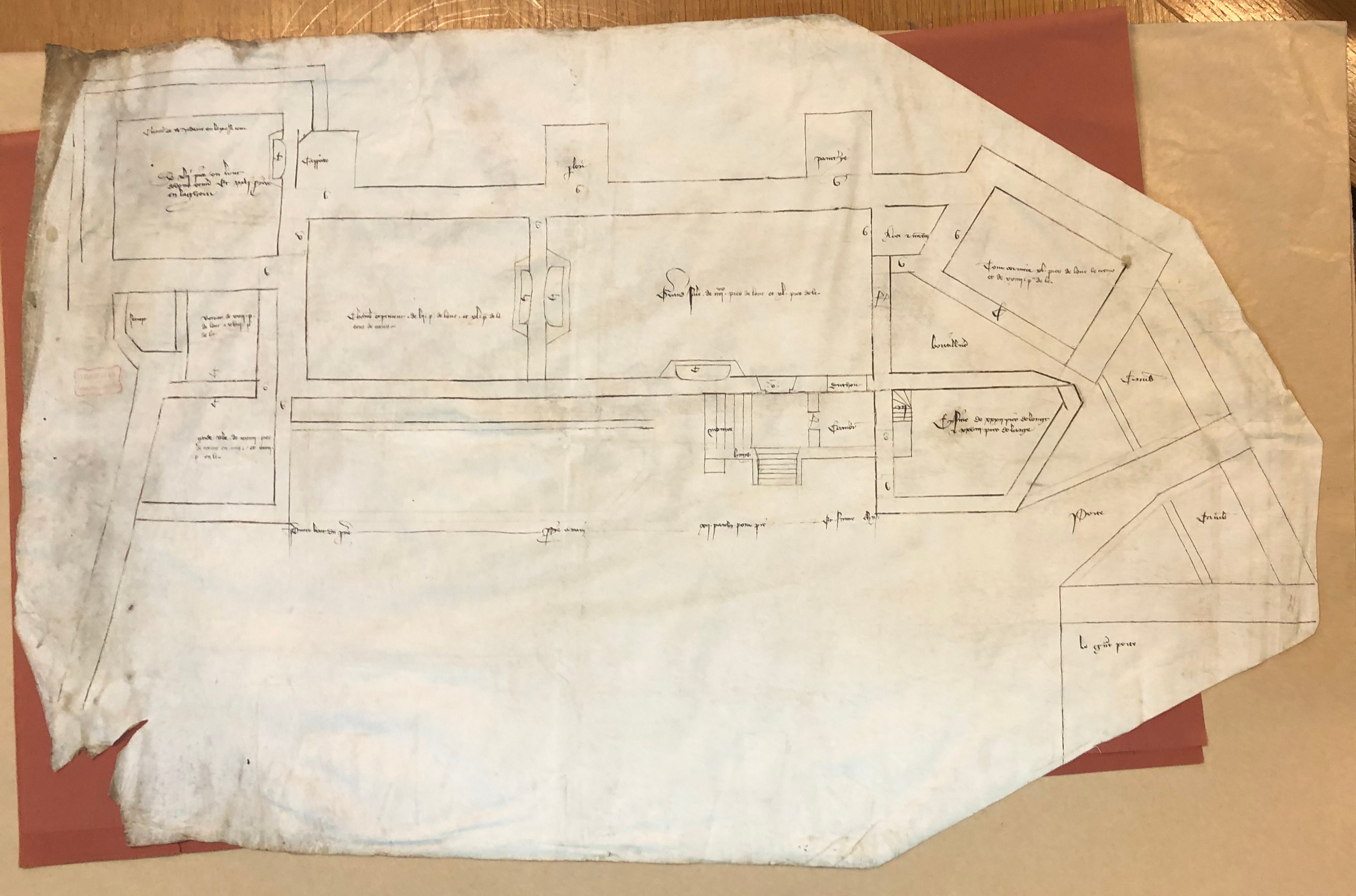Historical Elegance: Floor Plan of a Medieval Castle Layout offers a captivating glimpse into the architectural masterpieces of the past. Through careful design and meticulous attention to detail, medieval castles were not just fortresses, but symbols of power, wealth, and social status. Their floor plans were ingeniously crafted to serve both practical and aesthetic purposes, showcasing the complex hierarchy of the time.
The floor plan of a medieval castle consisted of various distinct areas, each with its own unique function. The keep, or central tower, stood tall and imposing, surrounded by a curtain wall that enclosed the inner bailey. Inside, one could find living quarters, great halls for banquets and gatherings, chapels for religious worship, and even defensive structures like moats and drawbridges. This intricate layout not only provided protection but also conveyed the grandeur and elegance associated with the medieval era. Today, these floor plans serve as a testament to the ingenuity and sophistication of medieval architecture, transporting us back in time to an age of chivalry and splendor.
Experience the grandeur of a medieval castle with its intricately designed floor plan. The layout of a medieval castle showcases its historical elegance with its strategic positioning of rooms, halls, and courtyards. From the imposing entrance gate to the majestic keep, each area has a specific purpose, reflecting the social hierarchy and defensive features of the time. Explore the fascinating architecture and organization of a medieval castle through its floor plan, a testament to the historical elegance of the era.

The Intricate Layout of a Medieval Castle
The floor plan of a medieval castle is a fascinating aspect of architectural history. It showcases the intricate design and strategic layout of these magnificent structures that were built centuries ago. The layout of a medieval castle was carefully planned to serve various purposes, including defense, administration, and residence for the noble occupants. Each castle had its own unique layout, but they all shared some common features that exemplified the historical elegance of the era. Let’s explore the floor plan of a medieval castle to understand how these grand structures were organized and operated during their time.
The Keep: The Heart of the Castle
The keep, also known as the central tower or donjon, was the main stronghold and living quarters of the castle. It was typically located in the center of the castle complex and served as the last line of defense in case of an attack. The layout of the keep was designed to provide maximum security and functionality.
Externally, the keep had thick stone walls, often with arrow slits and battlements for archers to defend against enemies. The entrance to the keep was typically raised from ground level and accessed by a drawbridge, which could be raised in times of danger. The keep also featured a main hall, known as the Great Hall, where the lord, his family, and guests would dine, hold meetings, and conduct ceremonies.
Internally, the keep was divided into multiple levels. The ground level often housed storerooms, kitchens, and living quarters for the castle staff and servants. The upper levels were dedicated to the noble family’s private chambers, including bedrooms, reception rooms, studies, and chapels. The topmost level usually had a lookout tower, providing a panoramic view of the surrounding landscape.
The Bailey: The Outer Courtyard
The bailey, also referred to as the outer courtyard, was an essential part of the castle’s layout. It was an enclosed area located outside the keep and served as a hub of castle activity. The bailey encompassed various structures, including workshops, stables, barracks, and storage facilities.
The layout of the bailey was designed to optimize functionality and efficiency. The main entrance to the bailey was often through a fortified gatehouse, which featured defensive elements such as a drawbridge, portcullis, and murder holes. This allowed the castle’s inhabitants to control access and monitor incoming and outgoing traffic.
The bailey housed essential facilities such as the blacksmith’s shop, where weapons and armor were crafted and repaired. It also accommodated stables for horses and other livestock, as well as granaries and storage areas for provisions. Barracks were constructed to house the castle garrison, consisting of soldiers and knights responsible for maintaining security and defending the castle.
The Inner Curtain Wall: Enclosing the Castle
The inner curtain wall was a crucial defensive feature of a medieval castle. It encircled the entire castle complex, including the keep and the bailey. The layout of the inner curtain wall served to protect the castle’s inhabitants from external threats.
The inner curtain wall was constructed with thick stone and featured fortified towers at regular intervals. These towers provided vantage points for archers and defenders to repel attacks. The curtain wall often incorporated defensive features such as arrow slits, crenellations, and machicolations.
Within the inner curtain wall, there were also additional structures that enhanced the castle’s defensive capabilities. These included gatehouses, barbicans, and moats. The gatehouses were fortified entrances to the castle, featuring mechanisms like drawbridges and portcullises. The barbican served as an outer defense before reaching the castle’s main entrance. Moats, often filled with water, surrounded the castle complex and acted as an additional obstacle for invaders.
The Chapel: A Place of Worship
Religion played a significant role in medieval society, and castles often included a chapel or church within their grounds. The chapel was a sacred space for worship and religious ceremonies, catering to the spiritual needs of the castle’s occupants.
The chapel was typically located within the inner curtain wall, close to the keep or the bailey. The layout of the chapel followed traditional ecclesiastical design, with features such as an altar, nave, choir stalls, and stained glass windows.
The chapel’s architecture and decorations were often elaborate, reflecting the wealth and status of the castle’s owner. The walls were adorned with religious paintings, tapestries, and ornate carvings. The chapel also had a resident chaplain or priest who conducted religious services and provided spiritual guidance to the castle’s inhabitants.
The Gardens: Serene Beauty amidst the Fortress
Although primarily designed for defense, medieval castles also sought to incorporate elements of beauty and tranquility, and gardens played a vital role in this regard. The presence of gardens within a castle complex added a touch of serenity and natural beauty amidst the formidable stone structures.
The gardens were typically located within the bailey or surrounding the keep. They featured various elements such as flowerbeds, herbs, fruit trees, and small ponds. The layout of the gardens followed formal designs, often inspired by monastic gardens and reflecting the prevailing horticultural practices of the time.
The castle’s occupants, particularly the noble family, could retreat to the gardens to find respite from the often harsh realities of medieval life. The gardens provided a peaceful setting for strolling, reflection, and even small gatherings or events, bringing a touch of outdoor elegance to the castle’s overall ambiance.
The Legacy of Medieval Castle Layouts
The floor plan of a medieval castle is an enduring testament to the historical elegance and architectural brilliance of the era. The intricate layout, defensive elements, and functional design of these castles continue to captivate historians, architects, and enthusiasts to this day. The castles served as symbols of power, prestige, and security, and their unique floor plans exemplify the creativity and ingenuity of the medieval period.
Historical Elegance: Floor Plan of a Medieval Castle Layout
When exploring the grandeur and architectural marvels of medieval castles, it is imperative to understand the intricate floor plans that were designed to provide maximum security and efficient functionality for their inhabitants. The layout of a medieval castle was carefully planned to serve various purposes, including defense, administration, living quarters, and entertainment.
Typically, a medieval castle floor plan consisted of different sections or wards, each serving a specific function. The outermost ward was known as the outer bailey, which housed stables, workshops, and other support buildings. The next ward, the inner bailey, contained the main living quarters, including the lord’s chamber, great hall, and chapel. The innermost ward housed the strongest defenses, including the keep and the tower.
| Outer Bailey | Housed stables, workshops, and support buildings |
| Inner Bailey | Main living quarters, including the lord’s chamber, great hall, and chapel |
| Innermost Ward | Strongest defenses, including the keep and the tower |
Within these sections, the rooms were arranged systematically, with communal spaces such as the hall and kitchens located on the ground floor, while private chambers and guest rooms were situated on the upper levels. The layout also featured strategic elements like narrow corridors, hidden passageways, and high walls to enhance security. The architectural elegance and attention to detail in a medieval castle floor plan showcased the wealth and power of the noble lords who resided within.
Key Takeaways: Historical Elegance: Floor Plan of a Medieval Castle Layout
- The floor plan of a medieval castle consists of multiple parts, such as the keep, bailey, and curtain walls.
- The keep is the central stronghold of the castle, typically containing the lord’s living quarters, great hall, and defensive towers.
- The bailey is an enclosed courtyard where auxiliary buildings, such as stables, workshops, and barracks, are located.
- The curtain walls surround the castle and provide a strong defense against attackers.
- Medieval castles were designed to be self-sufficient, with features like a well, kitchen, and storage rooms.
Frequently Asked Questions
Welcome to our FAQ section on the historical elegance of the floor plan of a medieval castle layout. We will answer some commonly asked questions to help you understand the architectural marvels of these castles.
1. What were the key features of a medieval castle floor plan?
The floor plan of a medieval castle typically consisted of several important features. Firstly, there was a large central courtyard known as the bailey, which served as the heart of the castle. Surrounding the bailey were defensive walls, towers, and gates to ensure the castle’s security.
Inside the castle, you would find the keep, also known as the main building. This was usually located at the highest point and served as both the residence of the lord or lady and the last line of defense in case of an attack. Additionally, there were various rooms, such as the great hall, chapel, kitchens, and living quarters for servants and soldiers.
2. Why were castles built with such complex floor plans?
Medieval castles were built with complex floor plans for several reasons. Firstly, they were designed to provide a strategic advantage in warfare. The intricate layout made it difficult for attackers to breach the castle defenses, with multiple layers of walls, towers, and heavily fortified gates.
Secondly, the floor plan was designed to accommodate the needs of the castle’s residents. The various rooms and living quarters were arranged in a way that provided privacy and comfort, while also allowing for efficient functioning of the castle and its daily operations.
3. How did the floor plan of a medieval castle reflect social hierarchy?
The floor plan of a medieval castle reflected the social hierarchy of the time. The lord or lady’s living quarters, including the private chambers and the Great Hall, were typically located in the keep. This highlighted their elevated status and authority within the castle.
On the other hand, the living quarters for servants, soldiers, and lower-ranking members of the castle community were usually situated in separate areas, often closer to the outer walls. This segregation of spaces emphasized the social divide and hierarchy within the castle.
4. How were medieval castle floor plans influenced by the surrounding landscape?
The surrounding landscape played a crucial role in shaping the floor plan of a medieval castle. Castles were strategically built on elevated sites, such as hills or rocky outcrops, to provide a natural advantage in terms of defense and visibility.
The layout of the castle would also be influenced by the natural features of the landscape. For example, a castle located near a river might have a water gate or drawbridge for easy access and defense. Additionally, the availability of resources like timber and stone in the surrounding area would impact the construction and design of the castle.
5. Can you provide examples of famous medieval castles with elaborate floor plans?
Certainly! There are numerous examples of famous medieval castles with elaborate floor plans. One such example is the Windsor Castle in England, which has a complex layout with multiple courtyards, towers, and defensive walls.
Another famous castle is the Château de Chillon in Switzerland, known for its intricate floor plan encompassing numerous chambers, courtyards, and a moat. The Alhambra in Granada, Spain, is also renowned for its intricate floor plan and architectural elegance.
What rooms are inside REAL medieval castles?
Exploring the floor plan of a medieval castle layout can provide a fascinating glimpse into the historical elegance of these architectural marvels. Each area of the castle served a specific function, from the grand halls where feasts and gatherings took place, to the formidable towers that provided defense and surveillance.
The layout of a medieval castle was carefully designed to not only showcase the power and wealth of its inhabitants but also to provide maximum security and functionality. From the imposing gatehouse to the intricate network of rooms and chambers, every element of the floor plan was crafted with precision and purpose.

